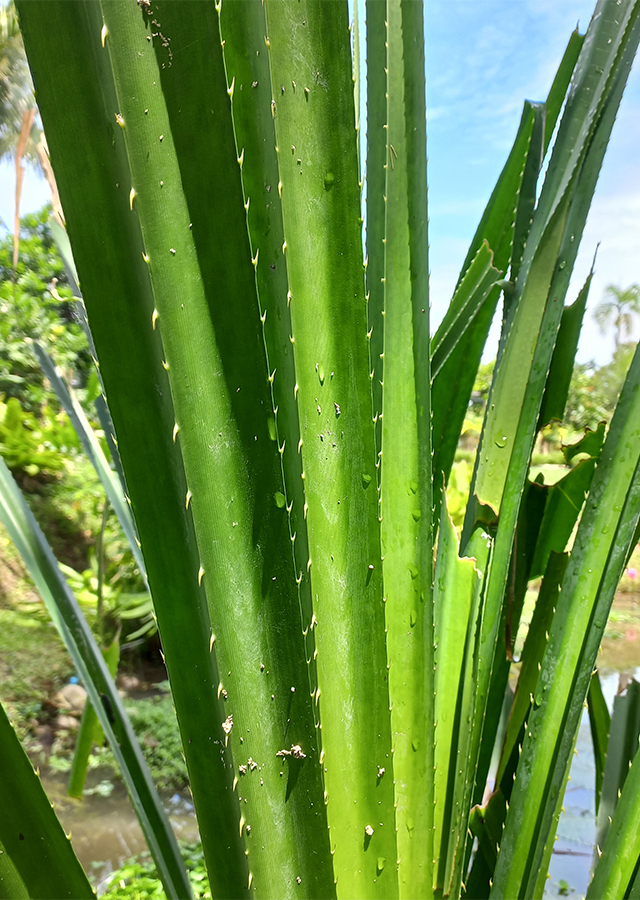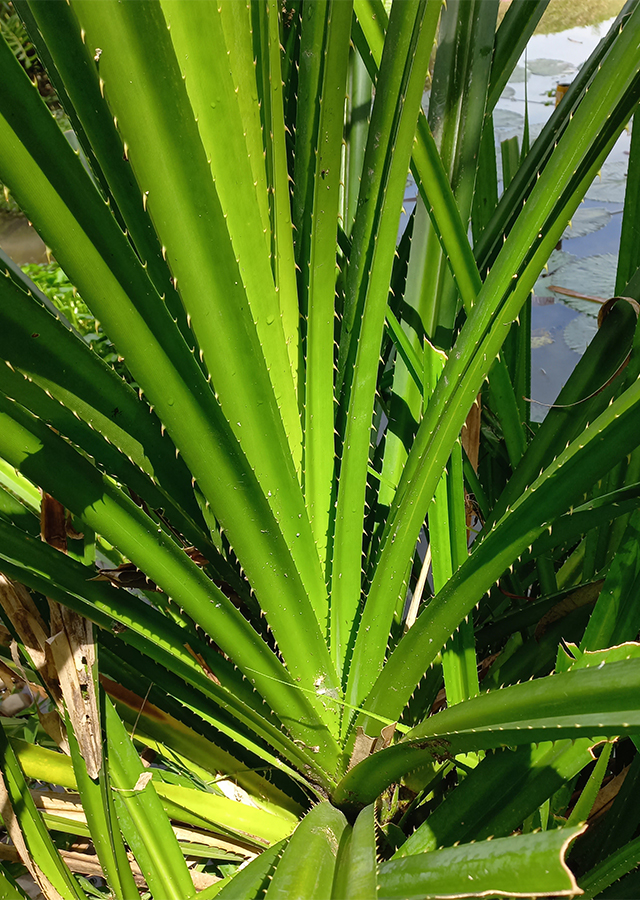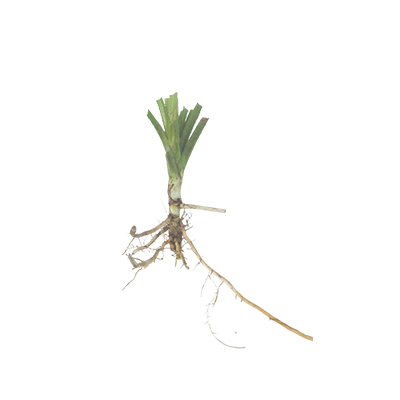Screw Pine
Pandanus tectorius Parkinson ex Du Roi
Pandanaceae
Location in our garden
Orchard



Synonym
Corypha laevis (Lour.) A.Chev.
Pandanus absonus H.St.John
Pandanus adscendens H.St.John
Habitus
Trees. A small, often multi-stemmed, evergreen tree with conspicuous prop roots and prickly stems, up to 14 m tall.
Part Used
Leaves
Bark
Roots
Growing Requirements
Full Sunshine
Need Shade
Drought Resistant
Habitat
Forest
Coastal
Roadside
Rocky Areas
Grassland
Terrestrial
Overview
Screw pine is native to the Pacific region (Micronesia, French Polynesia, New Caledonia, Solomon Islands and Vanuatu), the Philippines, Papua New Guinea, parts of Indonesia (including Irian Jaya, Java and the Moluccas) and Queensland in Australia. This plant is a multipurpose plant, that have numerous uses, including for food, fibre, compost, building materials, medicines, shade, shelter, as an ornamental, and for almost every possible use a tree could provide, including a wide range of environmental services, such as coastal erosion control, windbreaks and boundary markers. Various parts of the plant are edible. Terminal buds, inner base of young leaves, flower buds are cooked and eaten asa a vegetable. The seeds can also be cooked and consumed, but the seed contain calcium oxalate crystals, which irritate the mouth. These can be removed by cooking and straining the seeds. The trunk and large branches are used for building materials in house construction. Fibres from leaves are used to make mats, baskets and a variety of other products. An essential oil is obtained from the male flowers, and used in perfumery, cosmetics, hair oils, soaps. Male flowers are also used to scent coconut oil. A watery extract distilled from the male flowers (Kewra water), is used as a flavouring in desserts and drinks. Screw pine is produces fruit, that the extract of the fruit is used as an ingredient in commercial cosmetic preparations as a humectant. In adittion, all plant parts have various medicinal uses. It has traditionally been used in several countries as medicine, one of which is used in traditional Ayurvedic medicine.
Vernacular Names
Lu dou le, Lin tou (Chinese), Vacquois, Baquois, Vacouet (French), Pandanuspalme (German), Adan, Shima tako no ki (Japanese), Pandan laoet, Pandan pasir (Malay), Bacua (Spanish), Dua tro, Dua go (Vietnamese), Pandano (Portugal), Kadi (Arabic), Ananasso delle China (Italy).
Agroecology
Screw pine is a plant of lowland humid and subhumid tropical climates, rarely found above an elevation of 20 metres in the wild but cultivated at elevations up to 600 metres. It is found in areas where the mean annual temperature ranges from 24 - 28 °C, the mean temperature of the hottest month is 28 - 36 °C and that of the coldest month is 17 - 25 °C. The mean annual rainfall varies from 1,500 - 4,000 mm, with no dry season or a short dry season of 2 - 3 months. This species is prefers full sunlight, and occurs mostly in open, exposed sites, but can also grow in partial shade (30-50%). Although trees tend to stop flowering and fruiting under higher shade levels, and will not tolerate shade above 70%. It is resistant to fire, extended periods of soil waterlogging, and maritime exposure, including buffeting from moderate to severe tropical cyclones. Established plants can tolerate droughts of 3 - 6 months and will continue to fruit. Screw pine is adapted to an extraordinarily wide range of light to heavy textured soil types, including brackish/saline soils, lightcoloured, infertile coralline atoll sands, alkaline sands, thin soils over limestone, and peaty swamps. Grows well in moist and sandy soils and well-drained soil.
Morphology
- Roots - develops many prop and stilt roots from the bottom of the trunk or the side branches.
- Stems - erect, many branching, and have numerous aerial and prop roots and thick, covered with sharp conical prickles. Bark is greyish or reddish brown, smooth or flaky, with characteristic undulating leaf scars and rows of prickles.
- Leaves - dark green, linear lanceolate with a gradually attenuating apex, glaucous. The leaves are pleated, having a 'M' cross-section, and are spirally arranged in clusters at the tips of the branches, have short spiny or prickly 2.5 mm long midribs and margins, although a few varieties have leaves with smooth margins.
- Flowers - are borne in heads at the shoot apex. Dioecious, bearing male and female flowers on separate plants. Male plants are usually more branched, with up to about 30 branches (maximum 60), than females, which have up to about 15 branches (maximum 30). Female flowers are borne on a globose to subglobose flowering head, while male flowers are fragrant, tiny, white, pendant, arranged in racemes or branched in clusters, with large white showy bracts, and only last for about a day.
- Fruits - oval-shaped or ellipsoid to globose-ellipsoid, multiple fruit which resembles a pineapple, ripens from green to orange, fibrous. Comprised of 40-200 tightly bunched, wedge-shaped fleshy ‘keys’, phalanges or drupes, narrowly oblong to ovoid.
- Seeds - red-brown, obovoid, ellipsoid or oblong.
Cultivation
- Propagated by seed, pre-soak for 24 hours. To speed germination, soak the drupes in cool tap water for 5 days, changing the water every day. Germination takes about 2 months. Plants grown from seed can take 20 years to reach sexual maturity. Plants can remain productive for another 40 - 60 years or more.
- Propagated by rooted stem cuttings. Stems with aerial or prop roots are selected; about 2/3 of the leaves are trimmed off to reduce water loss; and the stems rooted in a sandy soil. Plants grown from cuttings can commence fruiting in 4 to 6 years. Fruiting can continue for another 20 - 25 years.
Chemical Constituents
Essential oils (diterpene, d-linalool, phenylethyl acetate, citral, phenylethyl alcohol ester, ester of phthalic acid, fatty acids, steroptene), alkaloids, glycosides, isoprene esters, tannins, phytosterols, saponins, phenolic compounds (pandanusphenol A and B), amino acids, terpenoids, flavonoids, steroids, pandanusin A, furanocoumarins, coumarins, monoglyceride, monosaccharide.
Traditional Medicinal Uses
- Decoction of roots believed to have aphrodisiac and cardiotonic properties.
- The aerial roots yield a decoction that is used as a beverage in the treatment of blennorrhoea. This decoction, combined with urethral injections of the sap of the base of the banana plant, is said to be a rapid cure for this malady.
- A decoction of the roots is used to treat haemorrhoids and a decoction of fresh or dried prop root drunk for diuretic effect.
- A small portion of the young root is heated over a fire then crushed on a smooth stone, the extracted juice is applied to the bites or wounds caused by any fish, beings said to ease the pain and promote healing.
- In Palau, roots used to make a drink to alleviate stomach cramps. Leaves used to alleviate vomiting.
- The bark is scraped in Zingiber leaf and the juice extracted into a cup. This liquid is drunk as a sedative for patients with mental health problems.
- Decoction of leaves is used to headache, arthritis, stomach spasms. The leaves, especially the basal white section of young leaves, are used in treatments for cold/flu, hepatitis, dysuria, asthma, boils and cancer.
- In Ayurveda, leaves used for filarial diseases, leucorrhea, leprosy, smallpox, scabies, syphilis and leukoderma.
- In Vanuatu, a spoonful of grated stem bark mixed with a small cup of grated coconut flesh used to induce sterility.
Part Used
Reference Sources
- Flora Fauna Web. 2021. Pandanus tectorius Parkinson. https://www.nparks.gov.sg/florafaunaweb/flora/5/2/5242. 22-11-2021.
- Stuartxchange. 2018. Philippine Medicinal Plants: Pandan. http://www.stuartxchange.org/Pandan.html. 22-11-2021.
- CAB International. 2021. Invasive Species Compendium: Pandanus tectorius (screw pine). https://www.cabi.org/isc/datasheet/38447#toPictures. 22-11-2021.
- Royal Botanic Gardens. 2021. Plants of the World Online: Pandanus tectorius Parkinson ex Du Roi. http://powo.science.kew.org/taxon/urn:lsid:ipni.org:names:895770-1. 22-11-2021.
- Useful Tropical Plants Database. 2021. Pandanus tectorius. http://tropical.theferns.info/viewtropical.php?id=Pandanus+tectorius. 22-11-2021.


